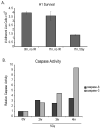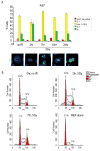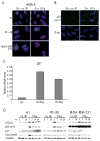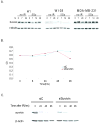Survival responses of human embryonic stem cells to DNA damage
- PMID: 19373864
- PMCID: PMC2925401
- DOI: 10.1002/jcp.21735
Survival responses of human embryonic stem cells to DNA damage
Abstract
Pluripotent human embryonic stem (hES) cells require mechanisms to maintain genomic integrity in response to DNA damage that could compromise competency for lineage-commitment, development, and tissue-renewal. The mechanisms that protect the genome in rapidly proliferating hES cells are minimally understood. Human ES cells have an abbreviated cell cycle with a very brief G1 period suggesting that mechanisms mediating responsiveness to DNA damage may deviate from those in somatic cells. Here, we investigated how hES cells react to DNA damage induced by ionizing radiation (IR) and whether genomic insult evokes DNA repair pathways and/or cell death. We find that hES cells respond to DNA damage by rapidly inducing Caspase-3 and -8, phospho-H2AX foci, phosphorylation of p53 on Ser15 and p21 mRNA levels, as well as concomitant cell cycle arrest in G2 based on Ki67 staining and FACS analysis. Unlike normal somatic cells, hES cells and cancer cells robustly express the anti-apoptotic protein Survivin, consistent with the immortal growth phenotype. SiRNA depletion of Survivin diminishes hES survival post-irradiation. Thus, our findings provide insight into pathways and processes that are activated in human embryonic stem cells upon DNA insult to support development and tissue regeneration.
Figures




References
-
- Abdul-Ghani M, Megeney LA. Rehabilitation of a contract killer: caspase-3 directs stem cell differentiation. Cell Stem Cell. 2008;2:515–516. - PubMed
-
- Aladjem MI, Spike BT, Rodewald LW, Hope TJ, Klemm M, Jaenisch R, Wahl GM. ES cells do not activate p53-dependent stress responses and undergo p53-independent apoptosis in response to DNA damage. Curr Biol. 1998;8:145–155. - PubMed
-
- Altieri DC. Survivin, versatile modulation of cell division and apoptosis in cancer. Oncogene. 2003;22:8581–8589. - PubMed
-
- Altieri DC. The case for survivin as a regulator of microtubule dynamics and cell-death decisions. Curr Opin Cell Biol. 2006;18:609–615. - PubMed
Publication types
MeSH terms
Substances
Grants and funding
LinkOut - more resources
Full Text Sources
Molecular Biology Databases
Research Materials
Miscellaneous

